跨文化交流Communication
跨文化交际unit6-verbal-communication

❖ 引言:
❖
各民族的语言是自足的. 处于不同语言世界里的人,即使面对同一个现实面向,
也会在描述它时沿着各自的思路,采用不同的策略, 刻画出不同的版本.正如维特
根斯坦所言:我的语言就是我的疆界,跨出我生于其中的语言,冒险与隔膜就开始
了.
❖
语言与文化紧密相连, 不可分割; 语言是文化的一部分.
❖ Culture and language are intertwined and are shaping each other. Each time we select words, form sentences, and send a massage, either oral or written, we also make cultural choices.
❖ ( Beamer, L. and Varner, I Intercultural communication in the Global Workplace. New York, NY:
❖ Teaching objectives: ❖ In this part you are expected to understand some commonly observed differences
The power of verbal communication
Ⅰ. cultural differences on lexical level ❖ (cases) ❖ 1. types of lexical meaning ❖ Words are the basic units of meaning. Understanding
❖ farther and farther away from home.
跨文化沟通(cross-culture_communication)

多元化
• 多元化的影响:在种族、性别、民族语言 以及性取向等问题在国家政治中日益受到 关注的同时,他们同样影响着人们的工作 环境。
• 原则:当别人跟你谈及一个话题时,要根 据你们两者间现有的相互了解的程度进行 讨论。(例如:打招呼)
cross-cultural communication
跨文化沟通:
定义:
跨文化沟通是指跨文化组织中拥有不同文化背景 的人们之间相互传递信息、交流知识和理解情感的过 程。
每个国家甚至每个族群都 有这自己特有的文化,有些 语言、动作、眼神、表情等 传达信息的方式在你自己所 在的区域内是代表着一种意 思但是在另外一个地方可能 就不是同一种意思。
• 解决多元化的困惑方式:
1、听从律师的建议。不要问一些连自 己都不知道答案的问题。 2、坦率地表露自己的文化困惑,向遇 到过类似困惑的同事寻求帮助。
1、文化困惑: 文化困惑存在在许多方面比如关于私人问题的困惑,商务交往中的困惑 ,民族文化的困惑及语言交流的困惑等等。 2、如何处理文化困惑: (1)、树立跨文化意识。可以主动学习对方的语言、历史、文化和风俗 习惯。 (2)、正确对待文化差异。首先要承认文化差异,其次要正确对到文化 差异。
当塞车时:
日本人:拉长了脸,呆在车里一心中的不耐烦。
美国人:往往拿出一支用 以减轻堵车烦恼的玩具冲 锋枪,扣动扳机,“哒哒” 地扫射一阵,据说此举能 帮助重获“心理平衡”。
德国人:此时应属于最奇特的一种,不但不心烦, 反而感到快乐,这在世界各民族中也许是绝无仅 有的。
• 在经济全球化的过程中,为了培养一名合适的管理人员,必须让他同 来自不同文化背景的学生一起学习
跨文化交流简介(Intercultural Communication)
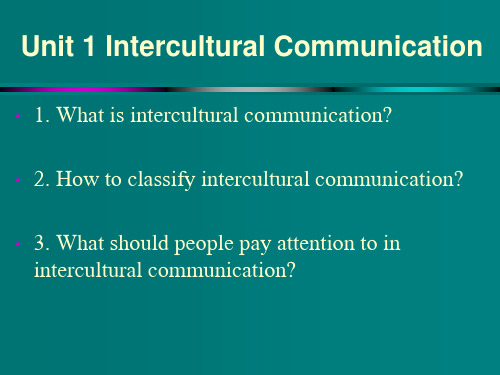
•
•
1. Intercultural communication as a human activity
•
The history of communication between people of different cultural backgrounds is almost as long as human history itself. Can you list any kinds of communication between people with different cultural backgrounds?
What is intercultural communication?
•
In the most general sense, intercultural communication occurs when a member of one culture produces a message for consumption by a member of another culture. More precisely, intercultural communication is communication between people whose perceptions and symbol systems are distinct enough to alter the communication event.(From Communication Between Cultures by Larry A. Samovar, Richard E. Porter & Lisa A. Stefani)
3. Founders of the Field of ICC
跨文化沟通(cross-culture-communication)

当塞车时:
日本人:拉长了脸,呆在车里一声不吭。
德国人:此时应属于最奇特的一种,不但不心烦, 反而感到快乐,这在世界各民族中也许是绝无仅 有的。一位德国工程师对此解释说,此时会产生 一种“共度难关”时的“同志式感觉”——大家 可以好好地一起感叹上一阵子,等道路畅通,一 种共同被“解放”的轻松感又会油然而生。 中国人:最有行动力的应当属于中国人,在焦急 等待中走出车厢,自己充当交警。
日本人是用眼吃饭: 说日本人用眼吃饭,并不是贬低日本人,而是日本人长期的岛国 心态,造就了他们的饮食习惯,由于日本是一岛国,物产相对来说比 较匮乏,有的食材需要长期进口,所以他们把饮食的风格放在少而精 上,做得量很少,但是食材选择以活的海鲜为主,用的器皿也是非常 讲究,但是都突出一个小字,让人吃起来赏心悦目,但是每次的食量 都不是太大,所以我们中国人吃日本料理都说吃不饱,而日本人却养 成这样的饮食习惯,所以你在日本很少见到大腹便便的人。
意大利人:不停地按喇叭, 以发泄心中的不耐烦。
奥地利人:往往猛烈击掌,表示焦急。
荷兰人: 一般会用 力跺脚, 表示“已 缺乏耐 心”。
视会 卢 后大 森 又扮 堡 大鬼 人 笑脸 : 。, 此 互时
美国人:往往拿出一支用 以减轻堵车烦恼的玩具冲 锋枪,扣动扳机,“哒哒” 地扫射一阵,据说此举能 帮助重获“心理平衡”。
cross-cultural communication
小组成员: 陈莎 赖瑶 阳靓芳 魏巧明 郑天 向卫平 唐文德
跨文化传播学关键术语解读

跨文化传播学关键术语解读跨文化传播学是研究不同文化之间的相互影响、交流和传播过程的学科。
在这个学科领域中,有一些关键术语是至关重要的,对于理解和解释跨文化传播现象具有重要意义。
下面将对其中几个关键术语进行解读,并提供相关参考内容。
1. 跨文化交流(intercultural communication):指不同文化之间的信息传递、理解和共享过程。
跨文化交流是解决文化差异问题和促进跨文化合作的重要手段。
参考内容:文化差异是跨文化交际的核心问题之一。
克里斯滕森(Christopher)指出,文化差异在跨文化交流中表现为语言和非语言差异、态度和价值观差异以及行为和礼仪差异。
在跨文化交际过程中,必须意识到并尊重对方的文化差异,同时培养跨文化沟通能力,以促进有效的交流和理解。
2. 文化霸权(cultural imperialism):指一个文化群体对其他弱势文化群体进行操控和影响的过程。
文化霸权常常伴随着经济、政治和军事力量的不平衡,在全球化的过程中比较常见。
参考内容:文化霸权是一个复杂的现象,常常存在于西方国家文化对其他国家的影响中。
尼尔(Neil)指出,文化霸权是一种意识形态的扩张,通过媒体、教育和商业等手段对其他文化进行塑造和影响。
反对文化霸权的观点认为,文化多样性是保护和发展每个国家独特文化的重要条件。
3. 文化认同(cultural identity):指一个人或群体对自己所属文化的认同感和归属感。
文化认同是个体和群体对自我身份的理解和建构的重要基础。
参考内容:文化认同是一个复杂的概念,常常与个体和社会的需求密切相关。
草本(Clayborne)指出,文化认同通过语言、价值观、习惯等方面的共同体验来建立,并在个体和群体的生活和行为中得以体现。
在跨文化传播中,理解和尊重他人的文化认同是建立和谐关系的重要前提。
4. 跨文化可信度(intercultural credibility):指在跨文化交流中,个体或群体在他人眼中符合期望、可靠可信的程度。
跨文化交际icc的理解
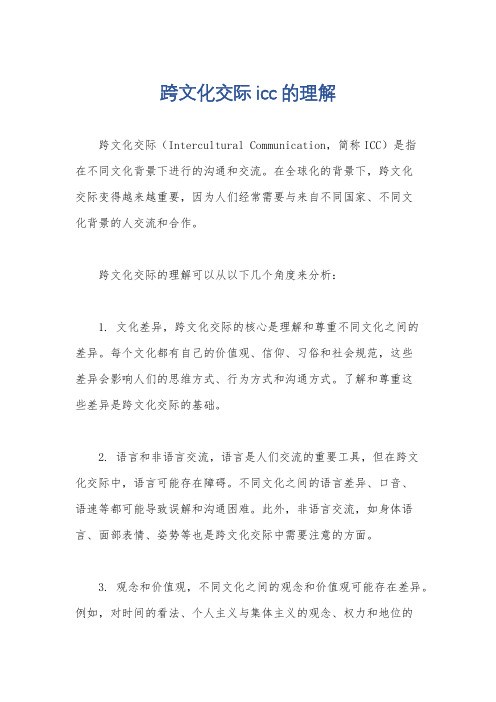
跨文化交际icc的理解跨文化交际(Intercultural Communication,简称ICC)是指在不同文化背景下进行的沟通和交流。
在全球化的背景下,跨文化交际变得越来越重要,因为人们经常需要与来自不同国家、不同文化背景的人交流和合作。
跨文化交际的理解可以从以下几个角度来分析:1. 文化差异,跨文化交际的核心是理解和尊重不同文化之间的差异。
每个文化都有自己的价值观、信仰、习俗和社会规范,这些差异会影响人们的思维方式、行为方式和沟通方式。
了解和尊重这些差异是跨文化交际的基础。
2. 语言和非语言交流,语言是人们交流的重要工具,但在跨文化交际中,语言可能存在障碍。
不同文化之间的语言差异、口音、语速等都可能导致误解和沟通困难。
此外,非语言交流,如身体语言、面部表情、姿势等也是跨文化交际中需要注意的方面。
3. 观念和价值观,不同文化之间的观念和价值观可能存在差异。
例如,对时间的看法、个人主义与集体主义的观念、权力和地位的认知等。
了解和尊重对方的观念和价值观,可以帮助建立良好的跨文化交际。
4. 文化敏感性,跨文化交际需要具备文化敏感性,即能够意识到自己的文化背景对交流的影响,并且尊重和适应对方的文化。
这包括对自己的文化偏见和刻板印象的认知,以及对不同文化之间的平等和互惠的态度。
5. 适应和灵活性,在跨文化交际中,适应和灵活性是非常重要的。
这意味着能够适应不同的沟通风格、礼仪习惯和社交规则,并且愿意调整自己的行为和语言,以更好地与对方进行交流。
6. 跨文化冲突解决,由于文化差异,跨文化交际中可能会出现冲突和误解。
解决跨文化冲突需要开放的心态、耐心和善意的沟通。
通过倾听、提问和解释,可以减少误解并找到共同的解决方案。
总而言之,跨文化交际是一种理解和尊重不同文化差异的沟通和交流方式。
它需要我们具备文化敏感性、适应能力和解决冲突的能力,以建立良好的跨文化关系。
通过有效的跨文化交际,我们可以促进文化交流、增进相互理解,并在全球化时代中实现更好的合作和发展。
Cross-cultural Communication 跨文化交际 PPT课件 (2)
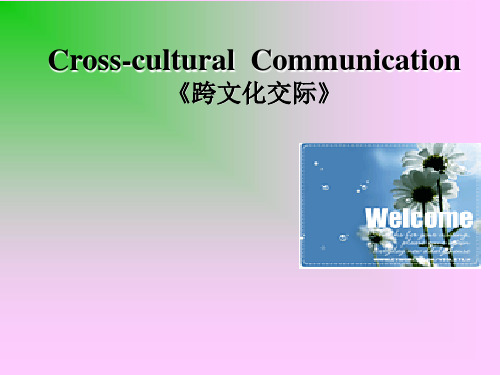
5.Case studies
Mutual Monitoring Process
Xiu went to a BC buffet reception in the BC headquarters in Beijing. It just so happened that Xiu arrived a little too early. The waiting lounge was almost empty except a charming lady sitting at a corner seat. After a long interval of unbearable silence Xiu decided to break the silence by approaching the lady.
Yes, but not good
1.An orator delivers a speech to a large gathering. 3. You send an e-mail message to an American friend. 4.Jane lies in bed reading a novel.
Model Two: unilateral-cultural model
(one knows another’s language and cultural environment but the other one doesn’t)
Lu Bing ,a Chinese tour guide is talking in English with George Luke, a British tourist who does not know Chinese at all.
Activity 3: Meanings in communication
跨文化交流Cross-culturalcommunication
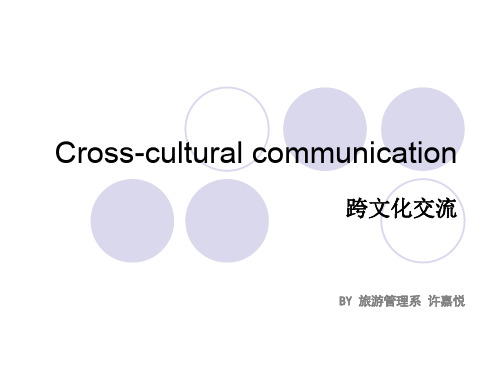
7.人口迁移
移民 人口老龄化 多文化社会
2005
2012年4月16日,7-11便利店将开放个人加 盟,年龄在22-52岁的中国籍人士,通过公 司审核后,投资30万即可成为便利店主。
试设想……
将来的某一天,你会有机会在一间全球连锁的企 业或者是她的子公司工作。
从发展现状来看,跨国公司已经成为重要的经济 体,在世界经济贸易中的地位日益突出。与政府 不一样的是,这些商业巨头并不透明,她们只对 自己的股东负责,甚少受到到规范约束。
全球化包括了涉及整个世界以及带来世界 范围内影响的一切行为和过程。
全球化(globalization)一词,是一种概念,也 是一种人类社会发展的现象过程。全球化目前有 诸多定义,通常意义上的全球化是指全球联系不 断增强,人类生活在全球规模的基础上发展及全 球意识的崛起。国与国之间在政治、经济贸易上 互相依存。全球化亦可以解释为世界的压缩和视 全球为一个整体。二十世纪九十年代后,随着全 球化势力对人类社会影响层面的扩张,已逐渐引 起各国政治、教育、社会及文化等学科领域的重 视,纷纷引起研究热潮。对于“全球化”的观感 是好是坏,目前仍是见仁见智。
请设想:
你在巴黎卢浮宫内游览,正在欣赏《蒙娜丽莎的 微笑》时,你妈妈给你打电话了。
你在北京坐公交车,正用手机在看一个有趣的视 频,但你身边的人正倾身跟你一起看这个视频。
你正在与一位沙特阿拉伯的客人一起开一个重要 的会议,这时候你公司的老总给你发信息来说, 你鼻血立刻给他回复他早前发给你的邮件。
达的信息 第七章 文化对语境的影响:商务情境 第八章 尝试进入新的文化:做一个优秀的跨文化
跨文化沟通

跨文化沟通(Cross-Cultural Communication),通常是指不同文化背景的人之间发生的沟通行为。
因为地域不同、种族不同等因素导致文化差异,因此,跨文化沟通可能发生在国际间,也能发生在不同的文化群体之间。
措施:1.培养跨文化意识。
具体来说就是导入要进行跨文化沟通对象的文化要素,树立文化差异的意识。
在有了这个意识的基础上,要主动地学习对方的语言、句式、文化,联系听说能力,以便更好地与对方进行沟通。
有了语言的基础后,就可以有针对性地比较沟通对象的文化与自己母文化的差异,提高对异文化差异的察觉。
2.在有条件的情况下可以,通过模拟真实情景(通常可以与熟悉目标文化的人员进行拍档),加强语言实践,强化文化差异性的适应能力。
3.正确对待文化差异,这其中包含了两个认知的层次。
第一个层次是正确地意识承认有文化差异的存在。
第二个层次是正确地对待文化的差异,积极的学习、适应、包容它。
这一个过程要注意保持不卑不亢的态度。
既不能有霸权文化意识,也不可以有自卑意识。
文化与国家或者地区的强弱并没有必要的联系。
4.熟悉掌握沟通的技巧。
在语言沟通中,要注意口语交流和书面沟通的不同层面的不同作用。
在与对方进行语言沟通的时候,要给足够停顿的时间给对方和自己进行语言交换。
此外还有注意在沟通时,不能先假设对方已经理解,反而应该先假设对方不能理解你的意思,通过不断的检查来估计对方对你的话语的理解能力。
5.培养非语言的沟通技巧。
在进行跨文化共同的时候应该要留意对方的身体语言。
我们可以借助观察对方的手势,面部表情等身体语言来了解他的意图;另外我们也要熟悉地使用身体语言,一方面可以运用身体语言更好地表达我们的意思弥补语言沟通的障碍,另一方面可以避免有歧义的身体语言的出现造成不必要的误会,例如手势。
由于各国的文化存在着多样性的特点,无论是表层的语言、礼仪,还是中层次的建筑、饮食、礼仪或者处于核心层次的民族价值观、思维等等。
这就决定我们在进行跨文化沟通的时候会遇到障碍和冲突,如何能有效地跨文化沟通具有十分重要的意义。
跨文化交际的英文表达

"Cross-cultural communication" 是指在不同文化背景下进行交流和理解的过程。
在许多情境下,人们可能会用以下表达来描述跨文化交际:
1. Intercultural Communication: 跨文化交际的常用术语。
2. Cultural Exchange: 文化交流,表示在不同文化间分享和交流信息。
3. Global Communication: 全球交流,指的是超越国界进行的跨文化沟通。
4. Diversity and Inclusion: 多元性与包容,强调在交际中考虑和尊重不同文化的多样性。
5. Interpersonal Understanding: 人际理解,强调在交流中理解和尊重他人的文化差异。
6. Cultural Sensitivity: 文化敏感性,指的是在交际中考虑并尊重他人的文化背景。
7. Adaptation and Adjustment: 适应与调整,表示在不同文化环境中调整自己的交际方式以融入当地文化。
8. Global Citizenship: 全球公民意识,鼓励个体在跨文化交际中具有开放、包容和全球意识。
9. Cultural Intelligence (CQ): 文化智商,强调个体在不同文化中有效交往的能力。
10. Bridging Cultural Divides: 架桥文化分歧,表示尝试弥合不同文化间的差异。
在任何跨文化交际中,理解文化差异的重要性以及尊重他人文化的价值观是关键。
这些表达可以帮助描述和促进在多元文化背景中的有效交际。
跨文化交际Communication is Culture and Culture is Communication

Communication is Culture and Culture is Communication Hall, an anthropologist, once said,“Communication is culture. Culture is communication.”I agree on what he said. The reasons why I think so are as followed:First of all, culture is the total accumulation of beliefs, customs, values, behaviors, institutions and communication patterns that are shared,learned and passed down through the generations in an identifiable group of people. And communication is one kind of culture’s living way.Secondly, communication is the activity or process of expressing ideas and feelings or of giving people munication is the act of conveying meanings from one entity or group to another through the use of mutually understood signs, symbols, and semiotic rules. So,culture need communication which helps it to be expressed and let other people know it is unique.Besides,the conversation you make is all based on your background, including your culture.In that way, communication is cultural conversation.Last but not least,culture is a whole collection of our living patterns and behaviors. Many cultures are defined by their communication styles and techniques. The formality of a culture, for instance, is instantly apparent in its tradition of greetings.As far as I am concerned,culture and communication can not live without each other.So I agree that communication is culture and culture is communication.。
跨文化交流Intercultural Communication
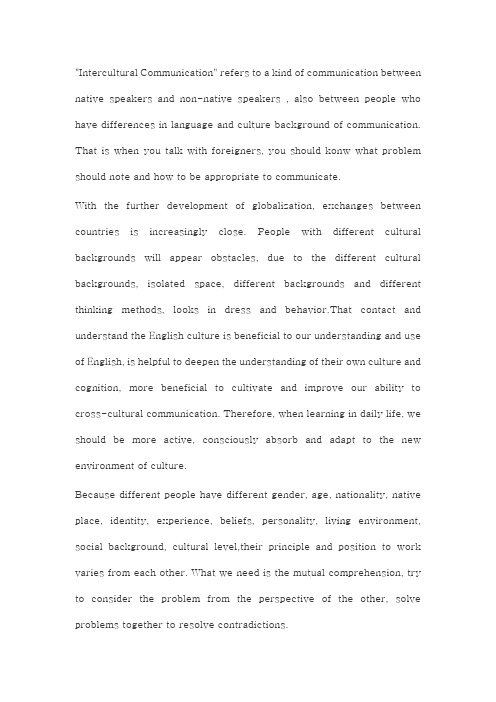
"Intercultural Communication" refers to a kind of communication between native speakers and non-native speakers , also between people who have differences in language and culture background of communication. That is when you talk with foreigners, you should konw what problem should note and how to be appropriate to communicate.With the further development of globalization, exchanges between countries is increasingly close. People with different cultural backgrounds will appear obstacles, due to the different cultural backgrounds, isolated space, different backgrounds and different thinking methods, looks in dress and behavior.That contact and understand the English culture is beneficial to our understanding and use of English, is helpful to deepen the understanding of their own culture and cognition, more beneficial to cultivate and improve our ability to cross-cultural communication. Therefore, when learning in daily life, we should be more active, consciously absorb and adapt to the new environment of culture.Because different people have different gender, age, nationality, native place, identity, experience, beliefs, personality, living environment, social background, cultural level,their principle and position to work varies from each other. What we need is the mutual comprehension, try to consider the problem from the perspective of the other, solve problems together to resolve contradictions.Chinese culture is based on Confucianism and Confucian thought is the basic cultural beliefs in East asia. While western culture originated in Greece and Rome, the source of western culture in Greek is rationalism and art, Renaissance, religious reform, the scientific revolution, the enlightenment is the motive force of the development of Western culture. Rationalism emphasizes scientific test, pay attention to the form of argument. The Anglo American countries, people pay more attention to the exact nature of the expression, it is difficult to understand the implication of the Chinese. For example, in Chinese culture, red represents luck, wealth and happiness, while Westerners concept, red is the color of blood, that impulse, provocation. So, Chinese like to wear red clothes in festivals, while the Westerners tend to choose blue, because they feel that blue represents calm and composure.。
跨文化交际--Unit-5-verbal-communication

Idioms习惯用语
• It’s raining cats and dogs. - It’s raining heavily.
• put one’s foot in one’s mouth - someone blunders by saying something he should not have.
的
– never-ending: everlasting 不停的
Synonyms
• 区分下列同义词:
同义词
– job
– vocation: job的正式用语
– profession: 脑力劳动者的职业
– field: 广义的职业“领域”
– occupation: 与vocation意思相近
– specialization: 具体的一个专长
UNIT 5
Verbal Communication
在全球化时代,要达到更高的成功几率,须努 力成为具有全球视野的国际化人才。学好至少一 门外语是必要的,但国际化人才最基本的素质是 跨文化沟通能力。 这是一种能够超越本族文化, 跨越不同文化鸿沟,穿透不同文化壁垒,在多元 文化的环境中游刃有余的能力。因此,你的外语 语言能力必须建立在理解不同文化的价值观体系 和行为规范模式之上, 其最终表现是能够适应、 掌控和化解多元文化环境中的矛盾和冲突。
• keep one’s hand in: • do activity in order to remain skilled at
it. • within arm’s reach; • sth.which you can reach easily. • ask for a woman’s hand; • to propose marriage. • put one’s finger on sth.: • to identify an error, or cause of a
跨文化交际——Cross-cultural communication
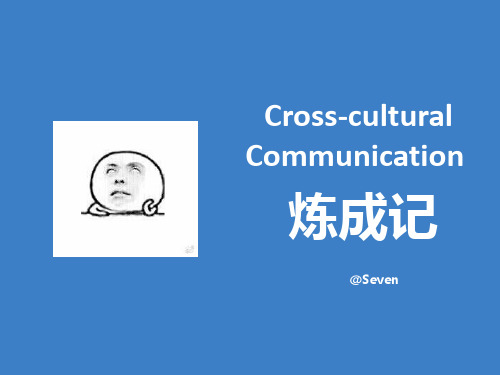
炼成记
@Seven
文化差异
1 情绪化障碍
2 障碍 6
认识上的误区非语言冒犯 Nhomakorabea3
5
4 价值观的差异
民族中心主义
1
跨文化意识是关键
提高文化敏感度,培养跨文化意识。
主动学习对方语言, 以便更好地沟通。
语言还是基础
2
走出“民族中心主义”, 树立文化全球化意识
避免不必要的 误会
5
恰当使用 身体语言
6
实践出真知
通过不断的实践,进行改进、积 累。加深对异文化的沉淀积累。
字箴言 尊重差异 包容个性 和谐共存 造福世界
Thanks!
世界是个地球村,这就意味着......
每个人和其他人都是联系的 所以我们应该学会跨文化沟通
正确对待文化差异
承认有文化差异的存在 正确对待文化的差异,学习适应包容。
既不能有霸权主义,也不能有
文化 自卑
4
本质是 沟通
技巧
话要说到 对方心里
给自己时间 思考,也给 对方时间反 应。
一个都不能 [少]
了解对方 身体语言
跨文化沟通(cross-culture-communication)ppt课件

中国人:最有行动力的应当属于中国人, 在焦急等待中走出车厢,自己充当交警。
.
.
VS
.
差异:
1、世界观的不同
4、学习目的的不同
2、宇宙观的不同
5、时间观的不同
3、思维方式的不同
6、沟通方式的不同
.
跨文化沟通障碍:
一、组织内部的沟通障碍 (1)员工结构的改变增加了沟通的难度 (2)组织层次和部门的冗杂,导致信息丢失 二、组织外部的沟通障碍 (1)信息多元化 (2)社会文化多元化 (3)组织外部沟通对象多元化
.
日本人是用眼吃饭: 说日本人用眼吃饭,并不是贬低日本人,而是日本人长期的岛国心
态,造就了他们的饮食习惯,由于日本是一岛国,物产相对来说比较匮 乏,有的食材需要长期进口,所以他们把饮食的风格放在少而精上,做 得量很少,但是食材选择以活的海鲜为主,用的器皿也是非常讲究,但 是都突出一个小字,让人吃起来赏心悦目,但是每次的食量都不是太大, 所以我们中国人吃日本料理都说吃不饱,而日本人却养成这样的饮食习 惯,所以你在日本很少见到大腹便便的人。
.
.
.
中国人是用嘴吃饭: 说中国人真正是用嘴吃饭,有人可能会说哪个国家的人不是用嘴
吃饭,他们还用鼻子吃饭不成。其实说中国人用嘴吃饭,是说中国人 吃饭最讲究口味,酸、甜、苦、辣,什么南甜北咸、东辣西酸。中国 八大菜系,各有自己的一套烹饪方法,讲究一个风味和口感。
.
当塞车时:
日本人:拉长了脸,呆在车里一声不吭。
cross-cultural communication
小组成员: 陈莎 赖瑶 阳靓芳 魏巧明 郑天 向卫平 唐文德
.
作为一个有抱负有理想的大学生,具备有效沟通的 能力是很重要的,而随着全球一体化,跨文化沟通 也越来越重要也越发普遍。
Cross-cultural-communication跨文化沟通
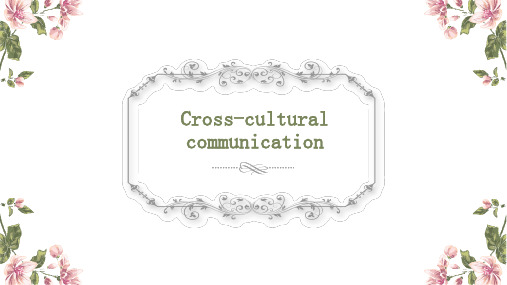
Together people with different ethnic, sociodemographic and ideological backgrounds
Origins and culture
International literacy and cross-cultural understanding have become critical to a country's cultural, technological, economic, and political health. It has become essential for universities to educate, or more importantly, “transform”, to function effectively and comfortably in a world characterized by close, multi-faceted relationships and permeable borders. Students must possess a certain level of global competence to understand the world they live in and how they fit into this world. This level of global competence starts at ground level-- the university and its faculty-- with how they generate and transmit cross-cultural knowledge and information to students.
跨文化交际与商务沟通

跨文化交际与商务沟通近年来,全球化进程愈演愈烈,跨文化交际在商务沟通中扮演着越来越重要的角色。
在全球商业社会中,各种文化、语言或思维方式的差异都会给商务交流带来障碍,使商务活动的顺利进行成为一项极具挑战性的工作。
一、跨文化交际的定义跨文化交际(Intercultural Communication)是指在不同文化或语言背景下的互动与联系。
这个概念包括了跨国企业、多文化团队、国际组织等多个层面下的交际活动。
在跨文化交际中,涉及到的文化、语言和沟通方式等因素都可能会影响到业务方面的决策和战略,进而影响公司的发展。
二、商务沟通的本质商务沟通(Business Communication)则是指商业交往中所进行的信息交流和互动,包括口头和书面的交流。
商务沟通关乎企业生存和发展的各个方面,例如市场拓展、投资、管理和营销等。
商务沟通的本质在于协助企业传递有效信息,促进商业活动的顺利进行。
跨文化交际和商务沟通不是完全独立的两个领域,而是互为支撑和重合的关系。
跨文化交际会对商务沟通产生影响,反之亦然。
跨文化交际的第一要义是了解并尊重不同的文化、语言,通过正确的沟通方式达成商务目标,商务沟通的目的在于提高业务效率,获得更好的商业结果。
在跨文化交际的过程中,企业必须能够将这两个领域结合起来,应用恰当的方式,从而达到更好的商业成果。
三、跨文化交际中的文化因素每种文化都有自己独特的价值观、信仰、沟通方式和行为习惯等。
不同文化间的差异会在商务交流中造成沟通障碍。
跨文化交际的时候,必须注意到这些差异,从而合理调整自己的行为方式,以便建立可信赖的跨文化商务关系。
在做生意的过程中,首先要尊重,用心倾听并理解不同文化中的习俗和语言。
例如,在中东,礼仪和热情非常重要,商务人士必须知道如何与客户建立良好的人际关系。
在中国,短信和电邮常常不够正式,商务活动还是要通过面对面的交流更加有效。
在做交易之前,在不同文化中建立深层次的理解和信任至关重要。
- 1、下载文档前请自行甄别文档内容的完整性,平台不提供额外的编辑、内容补充、找答案等附加服务。
- 2、"仅部分预览"的文档,不可在线预览部分如存在完整性等问题,可反馈申请退款(可完整预览的文档不适用该条件!)。
- 3、如文档侵犯您的权益,请联系客服反馈,我们会尽快为您处理(人工客服工作时间:9:00-18:30)。
CommunicationIt is a process of transferring information from one entity to another. Communication processes are sign-mediated interactions between at least two agents which share a repertoire of signs and semiotic rules.Communication is commonly defined as "the imparting or interchange of thoughts, opinions, or information by speech, writing, or signs".Communication is a process whereby information is enclosed in a package and is channeled and imparted by a sender to a receiver via some medium. The receiver then decodes the message and gives the sender a feedback. All forms of communication require a sender, a message, and an intended recipient; however the receiver need not be present or aware of the sender's intent to communicate at the time of communication in order for the act of communication to occur.Communication requires that all parties have an area of communicative commonality. There are auditory means, such as speech, song, and tone of voice, and there are nonverbal means, such as body language, sign language, paralanguage, touch, eye contact, through media, i.e., pictures, graphics and sound, and writing.Human communicationHuman spoken and written languages can be described as a system of symbols and the grammars can be described as rules by which the symbols are manipulated. The word "language" is also used to refer to common properties of languages. Language learning is normal in human childhood. Most human languages use patterns of sound or gesture for symbols which enable communication with others around them. There are thousands of human languages, and these seem to share certain properties, even though many shared properties have exceptions.Non-Verbal communicationNon-Verbal communication is the process of communicating through sending and receiving wordless messages. Such messages can be communicated through gesture, body language or posture; facial expression and eye contact, object communication such as clothing, hairstyles or even architecture, as well as through an aggregate of the above, such as behavioral communication. Nonverbal communication plays a key role in every person's day to day life, from employment to romantic engagements.Speech may also contain nonverbal elements known as paralanguage, including voice quality, emotion and speaking style, as well as prosodic features such as rhythm, intonation and stress.Likewise, written texts have Non-Verbal elements such as handwriting style, spatial arrangement of words, or the use of emoticons. A portmanteau of the English words emotion (or emote) and icon, an emoticon is a symbol or combination of symbols, such as :), used to convey emotional content in written or message form.Other communication channels such as telegraphy fit into this category, whereby signals travel from person to person by an alternative means. These signals can in themselves be representative of words, objects or merely be state projections. Trials have shown that humans can communicate directly in this way without body language, voice tonality or words.Categories and Features of Non-Verbal CommunicationG. W. Porter divides non-verbal communication into four broad categories:∙Physical. This is the personal type of communication. It includes facial expressions, tone of voice, sense of touch, sense of smell, and body motions.∙Aesthetic.This is the type of communication that takes place through creative expressions: playing instrumental music, dancing, painting and sculpturing.∙Signs. This is the mechanical type of communication, which includes the use of signal flags, the 21-gun salute, horns, and sirens.∙Symbolic. This is the type of communication that makes use of religious, status, or ego-building symbols.Static Features∙Distance.The distance one stands from another frequently conveys a Non-Verbal message. In some cultures it is a sign of attraction, while in others it may reflect status or the intensity of the exchange.∙Orientation.People may present themselves in various ways: face-to-face, side-to-side, or even back-to-back. For example, cooperating people are likely to sit side-by-side while competitors frequently face one another.∙Posture.Obviously one can be lying down, seated, or standing. These are not the elements of posture that convey messages. Are we slouched or erect? Are our legscrossed or our arms folded? Such postures convey a degree of formality and the degree of relaxation in the communication exchange.∙Physical Contact. Shaking hands, touching, holding, embracing, pushing, or patting on the back all convey messages. They reflect an element of intimacy or a feeling of (or lack of) attraction.Dynamic Features∙Facial Expressions.A smile, frown, raised eyebrow, yawn, and sneer all convey information. Facial expressions continually change during interaction and are monitored constantly by the recipient. There is evidence that the meaning of these expressions may be similar across cultures.∙Gestures. One of the most frequently observed, but least understood, cues is a hand movement. Most people use hand movements regularly when talking. While some gestures (e.g., a clenched fist) have universal meanings, most of the others are individually learned and idiosyncratic.∙Looking.A major feature of social communication is eye contact. It can convey emotion, signal when to talk or finish, or aversion. The frequency of contact may suggest either interest or boredom.Visual communicationVisual communication is communication through visual aid. It is the conveyance of ideas and information in forms that can be read or looked upon. Primarily associated with two dimensional(See also Three dimensional) images, it includes: signs, typography, drawing, graphic design, illustration, color and electronic resources. It solely relies on vision. It is form of communication with visual effect. It explores the idea that a visual message with text has a greater power to inform, educate or persuade a person. It is communication by presenting information through visual form.Understanding the Field of CommunicationThe field of communication is typically broken into three distinct camps: human communication, mass communications, and communication disorders.Human Communication or Communication Studies is the study of how individuals communicate. Some examples of the distinct areas that human communication scholars study are:∙Interpersonal Communication∙Organizational Communication∙Oral Communication∙Small Group Communication∙Intercultural Communication∙Nonviolent Communication∙Conflict∙Rhetoric∙Public Speaking∙Media and Communications PsychologyExamples of Mass Communications include:∙Mass communication∙Graphic communication∙Science communication∙Strategic Communication∙Superluminal communication∙Technical communication∙Public relations∙Broadcast Media∙Journalism∙Media and Communications PsychologyExamples of Communication Disorders include:∙Facilitated Communication∙Impairment of Language Modality∙Speech DisordersOral communicationOral communication is a process whereby information is transferred from a sender to receiver; in general communication is usually transferred by both verbal means and visual aid throughout the process. The receiver could be an individual person, a group of persons or even an audience.There are a few of oral communication types: discussion, speeches, presentations, etc. However, often when you communicate face to face the body language and your voice tonality has a bigger impact than the actual words that you are saying. "Communication is 55% body language, 38% tone of voice, 7% content of words", the so-called "7%-38%-55% rule”. For example, a person saying "I'm delighted to meet you" while mumbling, hunched over, and looking away will be interpreted as insincere.You can notice that the content or the word that you are using is not the determining part of a good communication. The “how you say it” has a major impact on the receiver. You have to capture the attention of the audience and connect with them. For example, two persons saying the same joke, one of them could make the audience die laughing related to his good body language and tone of voice. However, the second person that has the exact same words could make the audience stare at one another.In an oral communication, it is possible to have visual aid helping you to provide more precise information. Often enough, we use a presentation program in presentations related to our speech to facilitate or enhance the communication process.Written CommunicationW ritten communication is writing the words which you want to communicate. Good written communication is essential for business purposes. Written communication is practiced in many different languages. E-mails, reports, articles and memos are some of the ways of using written communication in business. The written communication can be edited and amended many times before it is communicated to the second party to whom the communication is intended. This is one of the main advantages of using writing as the major means of communication in business activity. Written communication is used not only in business but also for informal communication purposes. Mobile SMS is an example of informal written communication.。
